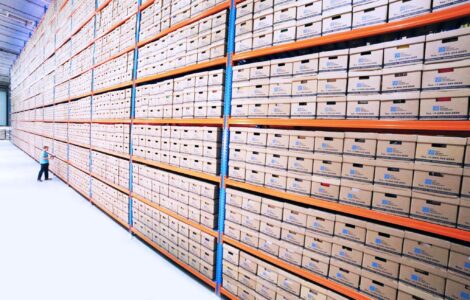
The term “Logistics 4.0” was coined few years ago in close association with the wider known “Industry 4.0” concept, which refers to successive industrial revolutions: from mechanization with steam engines, through electrification and computerization, and reaching the use of intelligent and automated systems based on data in the 4th revolution.
In Logistics, the same evolution has been followed and it is now the moment in which Artificial Intelligence is beginning to be used to improve processes. Throughout this evolution, logistics systems have become more efficient and robust, reducing operating costs and increasing the quality of service. The logistics areas of companies in sectors such as freight transport, delivery, retail, food and beverages, manufacturing, pharmaceuticals, etc., are beginning to incorporate Artificial Intelligence to achieve operational savings and not be left behind in the face of more efficient competition.
Artificial Intelligence is already applied in other enterprise areas, such as marketing, sales, customer service, etc., and now is the turn of logistics, more specifically logistics optimization to achieve operating costs savings.
Types of Artificial Intelligence tools for logistics optimization
There are two main lines or types of Artificial Intelligence tools being applied in logistics optimization:
- Predictive analytics, based mainly on Machine Learning / Deep Learning: It is possible to “train” systems with large volumes of data in order to make predictions. The ability to make predictions is essential to improve logistics processes. For example, if the volume of parcel delivery can be predicted over a period of time, it will be easier to dimension the right amount of resources to meet the demand.
- Prescriptive analytics, based on Operational Research (mathematical optimization techniques, simulation, etc.): In many logistics processes, decisions have to be made among a large number of options or possibilities. A human being can make a good decision, for example, to design delivery routes; however, it is probably not the optimal decision. And in these areas, the difference between a good decision and an optimal one translates into operating cost savings of 10-20%.
Where is Artificial Intelligence applied in logistics optimization?
Predictive and Prescriptive Analytics can be combined and applied in all logistics processes, which reinforce its improvement potential.
These are the main areas that are already being worked on, with very good results that translate into savings in a short period of time:
Hauling
In a complex environment in which there is a network design with platforms, local terrestrial hubs, intermodal hubs, intermediate warehouses, etc., the following challenges can be solved with Artificial Intelligence:
- Demand Forecast: Automatic daily generation of customer demand forecast for each node and pair of nodes.
- Estimation of hubs and offices resources: Daily generation of estimates of the resources needed for hubs and offices as well as for capillary distribution based on demand forecasts.
- Network Resource Estimation: Daily generation of high-level resource estimates required for network distribution.
Last mile routes
With the explosion of e-commerce, the optimization of last-mile routes has become a fundamental element to gain cost competitiveness. The challenge in this case is to find the optimal routes taking into account:
- Distances / times in vehicle: cost per kilometer traveled.
- Time windows for package pick up or drop off.
- Maximum vehicle capacity (weight and volume)
- Maximum distances to travel.
- Work schedules
- Etc.
Although there have long been tools to assist with these tasks, the increasing complexity and particularities of the problem require tailored tools to meet the savings potential in this aspect of logistics.
Staff shifts and schedules
Planning staff shifts and schedules is not an easy task when the logistics operation is complex and the number of people involved is high. Here the challenge lies in generating schedules that match personnel presence to predicted demand, taking into account, for example:
- X employees, Y managers, Z shifts.
- Challenges: individual preferences, vacations, forecasting demand.
- Risks: unmet demand (undersized), waste of resources (oversized)
This applies to shift planning for drivers, dock/ crossdocking personnel, office personnel, etc.
Vehicle and trailer maintenance
Currently, the types of maintenance carried out in the logistics and transport field are:
- Corrective maintenance, when there is a breakdown or accident.
- Preventive maintenance, which consists of periodic reviews to minimize the impact of breakdowns.
However, Artificial Intelligence allows you to achieve the potential savings possible with Predictive and Prescriptive Analytics:
- Predictive maintenance: It focuses on arranging the maintenance actions depending on the current state of the system to return a precise indication of when an intervention will be needed. The potential benefits are estimated to be:
- Reduction in maintenance costs: 25%-35%
- Elimination of unexpected failures: 70% -75%
- Repair time reduction: 35%-45%
- Prescriptive Maintenance: Focuses on optimizing and planning maintenance resources. It takes advantage of the information provided by the predictions to make economically efficient decisions.
Warehouses
Everything related to storage of goods in logistics processes is experiencing a revolution due to the use of Artificial Intelligence techniques in opposition to traditional techniques. Here are some of the areas where significant operational savings can be achieved:
- Warehouse configuration: Defining locations and assigning references to locations to minimize picking time:
- Compromise between ease of provisioning and use of space.
- Digital twin to decide locations and maximize productivity.
- Stock management: the objective is to decide the right times and quantities requested in the supply of products in order to reduce costs, and maintain certain policies on stocks in a coherent and automated way. It is taken into account:
- Forecasts of raw materials consumption.
- Storage capacity (warehouses or tanks).
- Expiration dates and other constraints.
- Supplier-related restrictions (delivery times, transport capacity, etc.)
Conclusion
Artificial Intelligence has been gradually implemented in different areas of the enterprise, and the time has come for Logistics, more specifically logistics optimization, to achieve cost savings estimated between 10% and 20%.
In this environment of strong competition, companies have entered the race to incorporate Artificial Intelligence in their logistics processes in order not to be left behind, and the best way to start is by identifying use cases in the areas mentioned above, in which the impact economic is high and ROI is assured.



